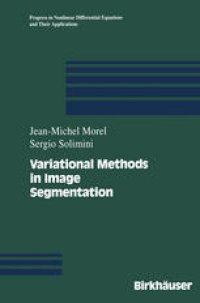
Ebook: Variational Methods in Image Segmentation: with seven image processing experiments
- Genre: Computers // Organization and Data Processing
- Tags: Computational Mathematics and Numerical Analysis, Visualization, Mathematical Modeling and Industrial Mathematics, Applications of Mathematics
- Series: Progress in Nonlinear Differential Equations and Their Applications 14
- Year: 1995
- Publisher: Birkhäuser Basel
- City: Boston
- Edition: 1
- Language: English
- djvu
This book contains both a synthesis and mathematical analysis of a wide set of algorithms and theories whose aim is the automatic segmen tation of digital images as well as the understanding of visual perception. A common formalism for these theories and algorithms is obtained in a variational form. Thank to this formalization, mathematical questions about the soundness of algorithms can be raised and answered. Perception theory has to deal with the complex interaction between regions and "edges" (or boundaries) in an image: in the variational seg mentation energies, "edge" terms compete with "region" terms in a way which is supposed to impose regularity on both regions and boundaries. This fact was an experimental guess in perception phenomenology and computer vision until it was proposed as a mathematical conjecture by Mumford and Shah. The third part of the book presents a unified presentation of the evi dences in favour of the conjecture. It is proved that the competition of one-dimensional and two-dimensional energy terms in a variational for mulation cannot create fractal-like behaviour for the edges. The proof of regularity for the edges of a segmentation constantly involves con cepts from geometric measure theory, which proves to be central in im age processing theory. The second part of the book provides a fast and self-contained presentation of the classical theory of rectifiable sets (the "edges") and unrectifiable sets ("fractals").
This text contains a synthesis and a mathematical analysis of a wide set of algorithms and theories whose aim is the automatic segmentation of digital images as well as the understanding of visual perception. A common formalism for these theories and algorithms is obtained in variational form. Thanks to the formalization, mathematical questions about the soundness can be raised and answered. Perception theory has to deal with the complex interaction between regions and "edges" (or boundaries) in an image; in the variational segmentation energies, "edge" terms compete with "region" terms in a way which is intended to impose regularity on both regions and boundaries. The first part of the book presents a unified presentation of the evidence in favour of the conjecture. It is proven that the competition of one-dimensional and two-dimensional energy terms in a variational formulation cannot create fractal-like behaviour for the edges. The proof of regularity for the edges of a segmentation constantly involves concepts from geometric measure theory, which proves to be central in image processing theory. The second part of the book provides a fast and self-contained presentation of the classical theory of rectifiable sets (the "edges") and unrectifiable sets ("fractals").